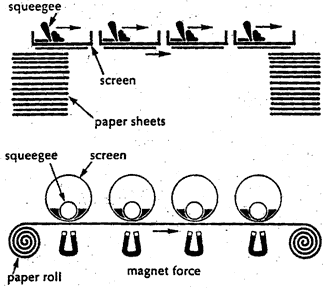Company Blog
Products for Filtration, Separation, Sifting and Printing
Screen Printing
- Font size: Larger Smaller
- Hits: 8117
- Subscribe to this entry
- Bookmark

Applications:
Screen printing (or silk printing) is arguably the most versatile of all printing processes. It can be used to print on a wide variety of substrates, including paper, paperboard, plastics, glass, metals, fabrics, and many other materials. including paper, plastics, glass, metals, nylon and cotton. Some common products from the screen printing industry include posters, labels, decals, signage, and all types of textiles and electronic circuit boards. The advantage of screenprinting over other print processes is that the press can print on substrates of any shape, thickness and size.
A significant characteristic of screen printing is that a greater thickness of the ink can be applied to the substrate than is possible with other printing techniques. This allows for some very interesting effects that are not possible using other printing methods. Because of the simplicity of the application process, a wider range of inks and dyes are available for use in screen printing than for use in any other printing process.
Utilization of screenprinting presses has begun to increase because production rates have improved. This has been a result of the development of the automated and rotary screenprinting press, improved dryers, and U.V. curable ink. The major chemicals used include screen emulsions, inks, and solvents, surfactants, caustics and oxidizers used in screen reclamation. The inks used vary dramatically in their formulations (GATF 1992b)
Screen Printing Process Overview
Screen printing consists of three elements: the screen which is the image carrier; the squeegee; and ink. The screen printing process uses a porous mesh stretched tightly over a frame made of wood or metal. Proper tension is essential to accurate color registration. The mesh is made of porous fabric or stainless steel mesh. A stencil is produced on the screen either manually or photochemically. The stencil defines the image to be printed in other printing technologies this would be referred to as the image plate.
Screen printing ink is applied to the substrate by placing the screen over the material. Ink with a paint-like consistency is placed onto the top of the screen. Ink is then forced through the fine mesh openings using a squeegee that is drawn across the scree, applying pressure thereby forcing the ink through the open areas of the screen. Ink will pass through only in areas where no stencil is applied, thus forming an image on the printing substrate. The diameter of the threads and the thread count of the mesh will determine how much ink is deposited onto the substrates.
Many factors such as composition, size and form, angle, pressure, and speed of the blade (squeegee) determine the quality of the impression made by the squeegee. At one time most blades were made from rubber which, however, is prone to wear and edge nicks and has a tendency to warp and distort. While blades continue to be made from rubbers such as neoprene, most are now made from polyurethane which can produce as many as 25,000 impressions without significant degradation of the image.
If the item was printed on a manual or automatic screen press the printed product will be placed on a conveyor belt which carries the item into the drying oven or through the UV curing system. Rotary screen presses feed the material through the drying or curing system automatically. Air drying of certain inks, though rare in the industry, is still sometimes utilized.
The rate of screen printing production was once dictated by the drying rate of the screen print inks. Do to improvements and innovations the production rate has greatly increased. Some specific innovations which affected the production rate and has also increased screen press popularity include:.
- Development of automatic presses versus hand operated presses which have comparatively slow production times.
- Improved drying systems which significantly improves production rate.
- Development and improvement of U.V. curable ink technologies
- Development of the rotary screen press which allows continuous operation of the press. This is one of the more recent technology developments.
Screen Preparation
Screen (or image transfer) preparation includes a number of steps. First the customer provides the screen printer with objects, photographs, text, ideas, or concepts of what they wish to have printed. The printer must then transfer a "picture" of the artwork (also called "copy") to be printed into an "image" (a picture on film) which can then be processed and eventually used to prepare the screen stencil.
Once the artwork is transferred to a positive image that will be chemically processed onto the screen fabric (applying the emulsion or stencil) and eventually mounted onto a screen frame that is then attached to the printing press and production begins.
Screen Printing Presses
There are three types of screen printing presses. The flat-bed (probably the most widely used), cylinder, and rotary.
Until relatively recently all screen printing presses were manually operated. Now, however, most commercial and industrial screen printing is done on single and multicolor automated presses.
Screen Reclamation (post-press)
Why reclaim screens?
Polyester fabric costs $10-40 per square yard.
Failure to reclaim screens and ruined screens cost on average $5,000-$10,000 per year. The average monthly fabric cost $360. One study showed chemical reclamation cost between 2 and 10 dollars per average screen, while screen disposal cost just shy of 50 dollars.
The process of reclaiming screens generates solvent waste and waste water. Solvent waste generated from screen cleaning and waste water is generated through the process of emulsion removal. The waste water will contain particulates comprised of ink pigment, emulsion and emulsion remover (periodate).
Screen Printing Inks
Screen printing inks are moderately viscous inks which exhibit different properties when compared to other printing inks such as offset, gravure and flexographic inks though they have similar basic compositions (pigments, solvent carrier, toners, and emulsifiers). There are five different types of screen ink to include solvent, water, and solvent plastisol, water plastisol, and UV curable.



